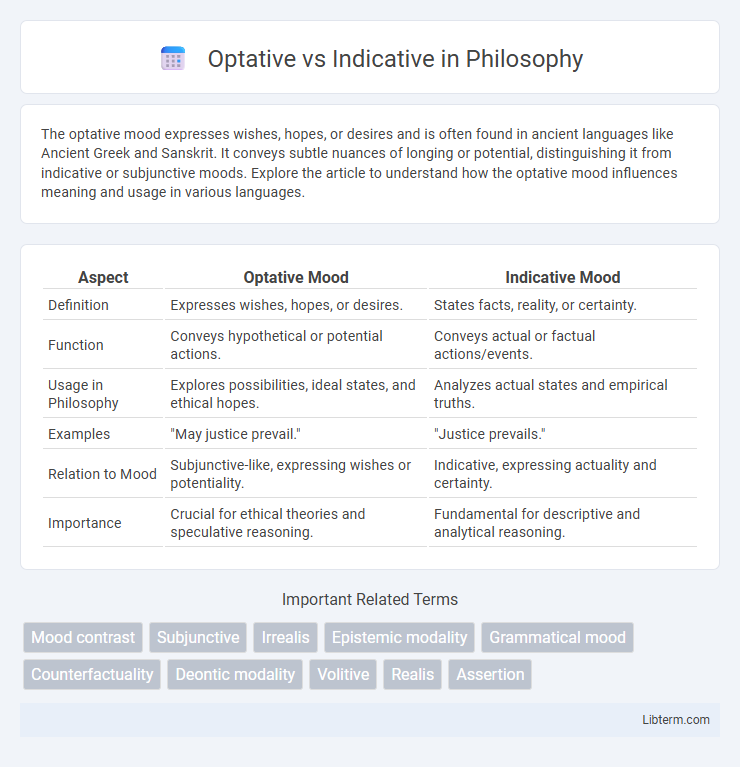The optative mood expresses wishes, hopes, or desires and is often found in ancient languages like Ancient Greek and Sanskrit. It conveys subtle nuances of longing or potential, distinguishing it from indicative or subjunctive moods. Explore the article to understand how the optative mood influences meaning and usage in various languages.
Table of Comparison
| Aspect | Optative Mood | Indicative Mood |
|---|---|---|
| Definition | Expresses wishes, hopes, or desires. | States facts, reality, or certainty. |
| Function | Conveys hypothetical or potential actions. | Conveys actual or factual actions/events. |
| Usage in Philosophy | Explores possibilities, ideal states, and ethical hopes. | Analyzes actual states and empirical truths. |
| Examples | "May justice prevail." | "Justice prevails." |
| Relation to Mood | Subjunctive-like, expressing wishes or potentiality. | Indicative, expressing actuality and certainty. |
| Importance | Crucial for ethical theories and speculative reasoning. | Fundamental for descriptive and analytical reasoning. |
Understanding the Optative Mood
The optative mood expresses wishes, hopes, or desires, often used in classical and some modern languages to convey actions that are hoped to occur rather than stated as facts. Unlike the indicative mood, which presents statements of reality or certainty, the optative mood allows speakers to articulate possibilities or hypothetical outcomes. Mastery of the optative mood enhances comprehension of nuanced emotional or intentional contexts in texts, especially in ancient Greek, Sanskrit, and certain dialects where this mood frequently appears.
Defining the Indicative Mood
The indicative mood expresses factual statements, objective realities, and certainty, serving as the most common mood in English and other languages. It is used to describe actions, events, or states that are believed to be true or real, such as "She walks to school" or "The sky is blue." The indicative mood contrasts with the optative mood, which conveys wishes, hopes, or hypothetical situations rather than concrete facts.
Key Differences Between Optative and Indicative
The optative mood expresses wishes, hopes, or potential actions, often found in classical languages like Greek, while the indicative mood conveys factual statements and real events. Optative sentences typically use verbs in specialized forms to indicate desire or possibility, whereas indicative sentences use verbs formed to state certainty or actual occurrences. Understanding these key differences facilitates better interpretation of sentence intent and nuances in meaning across various linguistic contexts.
Usage of Optative Mood in Sentences
The optative mood expresses wishes, hopes, or potential actions and frequently appears in sentences with verbs like "may," "wish," or "let." It differs from the indicative mood, which states facts or asks questions. For example, "May you succeed" uses the optative to convey a wish, contrasting with the indicative "You succeed" that states a fact.
Usage of Indicative Mood in Sentences
The indicative mood is used to state facts, express certainty, and describe real events or actions occurring in the present, past, or future. It appears in declarative sentences such as "She walks to school" or "They finished the project on time." In contrast to the optative mood, which expresses wishes or hopes, the indicative is the default mood for straightforward communication of reality.
Optative vs Indicative: Sentence Structure
Optative sentences primarily use verbs in the optative mood to express wishes, hopes, or potential actions, often introduced by particles such as "may" or "let" in English. Indicative sentences, on the other hand, use the indicative mood to state factual information, describe events, or ask questions with straightforward verb forms. The sentence structure in optative mood typically involves a more subjunctive or hypothetical verb conjugation, while indicative sentences follow the standard subject-verb-object order reflecting reality.
Common Verbs Used in Optative and Indicative
Common verbs used in the optative mood include wishes, hopes, and desires, such as "may," "wish," and "hope," expressing potential or hypothetical actions. In contrast, the indicative mood utilizes verbs like "is," "has," and "runs" to state facts, beliefs, or actual events with certainty. Understanding the verb forms and their context helps distinguish between expressing reality (indicative) and possibility or desire (optative).
Optative and Indicative in Classical Languages
In Classical Greek, the optative mood expresses wishes, potentiality, and hypothetical scenarios, often used to convey polite requests or future possibilities. The indicative mood serves to state facts, assert reality, and describe actions within a definite time frame, typically present, past, or future. Distinguishing the optative from the indicative allows precise nuanced expression of intention and reality in classical texts such as Homer's epics and Plato's dialogues.
Practical Examples: Optative vs Indicative
The optative mood expresses wishes, hopes, or hypothetical situations, commonly using verbs like "may" or "let," as in "May you succeed" or "Let there be peace." The indicative mood states facts or asks questions with certainty, such as "You succeed" or "Are you succeeding?" Practical examples highlight "If only he were here" (optative) versus "He is here" (indicative), showing the contrast between expressing desire and stating reality.
Tips for Mastering Mood Selection
Mastering mood selection between optative and indicative requires understanding their distinct functions: the optative mood expresses wishes, hopes, or potential actions, while the indicative mood states facts or asks questions. Practice identifying context clues in sentences to determine whether the speaker conveys possibility or certainty. Regular exposure to authentic texts and exercises emphasizing mood differences enhances accuracy in choosing the correct mood.
Optative Infographic

 libterm.com
libterm.com